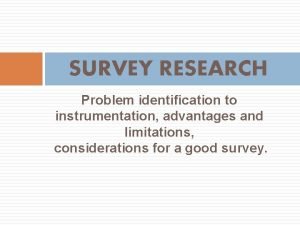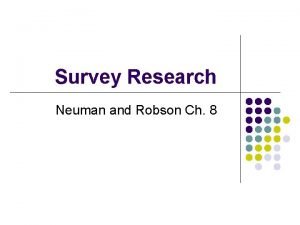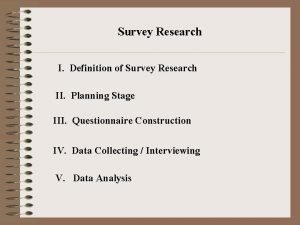Descriptive Research z Survey research z Developmental studies













- Slides: 13

Descriptive Research z. Survey research z. Developmental studies z. Follow-up studies z. Sociometric Studies 1

Surveys z. Researcher samples a portion of a large population z. Allows to infer the current status of an issue Nutritional practices Exercise patterns 2

Developmental Studies z. Changes in behavior due to age, growth or maturation z. Cross-sectional- multiple ages studied simultaneously z. Longitudinal - same group studied across time 3

Follow-up Studies z. Used to determine status after a period of time z. Determine the effectiveness of a program 4

Sociometric Studies z. Assessment and analysis of interpersonal relationships z. Interpreted by way of sociogram 5

Conducting Descriptive Research Developing the Questionnaire z Pros y. Efficient y. May be mailed y. Developed to meet the needs of the researcher z Cons y. Difficult to construct y. May not be returned 6

Getting Started z. Statement of the Problem z. Selection of subjects y. Subjects must be willing to participate 7

Questionnaire Construction z Attractive and brief z Avoid items not pertinent to study z Responses usually yes/no or multiple choice z Word each question based on 1 concept z Standardize the directions for administration 8

Preparing the cover letter z. Used to motivate subjects to respond z. Explains the purpose of the study and gives good reason to return z. Anonymity should be assured z. Deadlines dates should be given 9

Pre-Testing the Questionnaire z. Pilot the survey z. Proof read by 2 or 3 colleagues z. Mailed to a small sample z. If return rate is low, examine the instrument and the letter 10

Follow-up z 70% of your surveys should be returned for your study to be valid z. Send a reminder z. Send a second set of questions with a new cover letter 11

Analysis of Results z. Report response rates for each item z. Report overall percentage of returns z. May compare responses across items z. Cannot establish a direct cause and effect 12

Other Descriptive Research Techniques z. Interview Technique z. Observational Research y. Naturalistic y. Simulation y. Meta-analysis 13
 Descriptive research images
Descriptive research images Descriptive method research
Descriptive method research Advantages of descriptive research
Advantages of descriptive research Descriptive method research
Descriptive method research Abcd acls
Abcd acls Paradigm shift from women studies to gender studies
Paradigm shift from women studies to gender studies Descriptive study example
Descriptive study example Solomon four group design
Solomon four group design Research methods in developmental psychology
Research methods in developmental psychology Developmental research design
Developmental research design Research instrument example
Research instrument example Advantages of survey research
Advantages of survey research Survey definition in research
Survey definition in research Advantages of survey research
Advantages of survey research

























